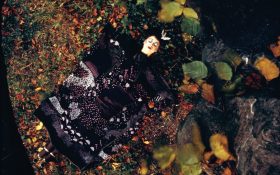AfterShock (one word) is the umbrella title for the Sainsbury Centre’s summer exhibition and events, including a film series, a symposium, talks, a summer school and even a family fun day. Nearly all of these have run their course, and the exhibition itself is only a week from closing. The building is UEA’s crowning glory and has been since it opened thirty years ago. Norman Foster made a great job of this one. It might have been opened yesterday, so clean, fresh and still cutting-edge is it in all aspects from masterplanning to detail. Sad then that it sits nearby Lasdun’s ziggurat student residences, which in form and material copy his equally poor National Theatre.
The AfterShock exhibition has a sub-title: Conflict, Violence and Resolution in Contemporary Art. The blurb says that it draws on the idea of a wave of energy that reverberates through the earth after the main shock of an earthquake. The idea is that the works will prompt us to think about how violence echoes through nations, communities and day-to-day lives, and it aims to show that the truth lies somewhere immersed in the multiplicity of images. OK, maybe it does, but I couldn’t engage with large parts of it at all. Of the sixteen artists who have contributed, two, both working in photography, drew me in and both sets could stand outside the umbrella brief very happily.
Jitish Kallat documents the clearance of slum dwellings in Mumbai, his home town, through twenty lenticular prints called Cenotaph (A Deed of Transfer). Framed, glazed and multi-layered, the prints have no focus or subject but are fragments of a whole. All are the same size and are clearly designed to exist as a set. That more artists haven’t got hold of this technology, famously used for the cover of Their Satanic Majesties Request, is baffling.
Best in show is Simon Norfolk. His large scale photographs are spectacular and full of incredible detail. Long Exposure with Insects is dazzling. It looks superficially like hopelessly tangled barbed wire, the wings and flight paths of each insect having been caught by night lighting. Another image, of the BBC World Service Atlantic Relay Station at English Bay, Ascension Island, is a stunning geometric tracery of wires on a grey sky background. I want it, but first I must build some more walls.
The Sainsbury Collection is in many ways similar to Glagow’s Burrell Collection, consisting of eclectic pieces gathered or acquired because of their personal appeal. Down in the basement you’ll find a small Jackson Pollock and scattered throughout are no less than thirteen Bacons, none of them identified but each placed in a prominent position, thus indicating one of the Sainsburys’ favoured artists. The one piece of visual art that has no peers is a mummy portrait from first century Egypt. Painted on wood, it depicts the head and upper torso of a youth. The astonishing quality of the image, which displays layered brush strokes, is staggering for its age. It is in every way a modern portrait – one which stares straight back at the viewer.
Sir Robert Sainsbury has frequently said that the building is the best thing in the collection. The spiral staircases are certainly things of real beauty, the toilets are years ahead of their time and the atmosphere created in the main space of the building is just perfect. A silver head of the architect is placed on a plinth facing the servery of the ground floor café. He looks serious, worried almost. In the complete ensemble of building and contents, it is the only thing out of place. It would be better out of the place.
Aftershock runs until 2 September at the Sainsbury Centre for Visual Arts in Norwich.




